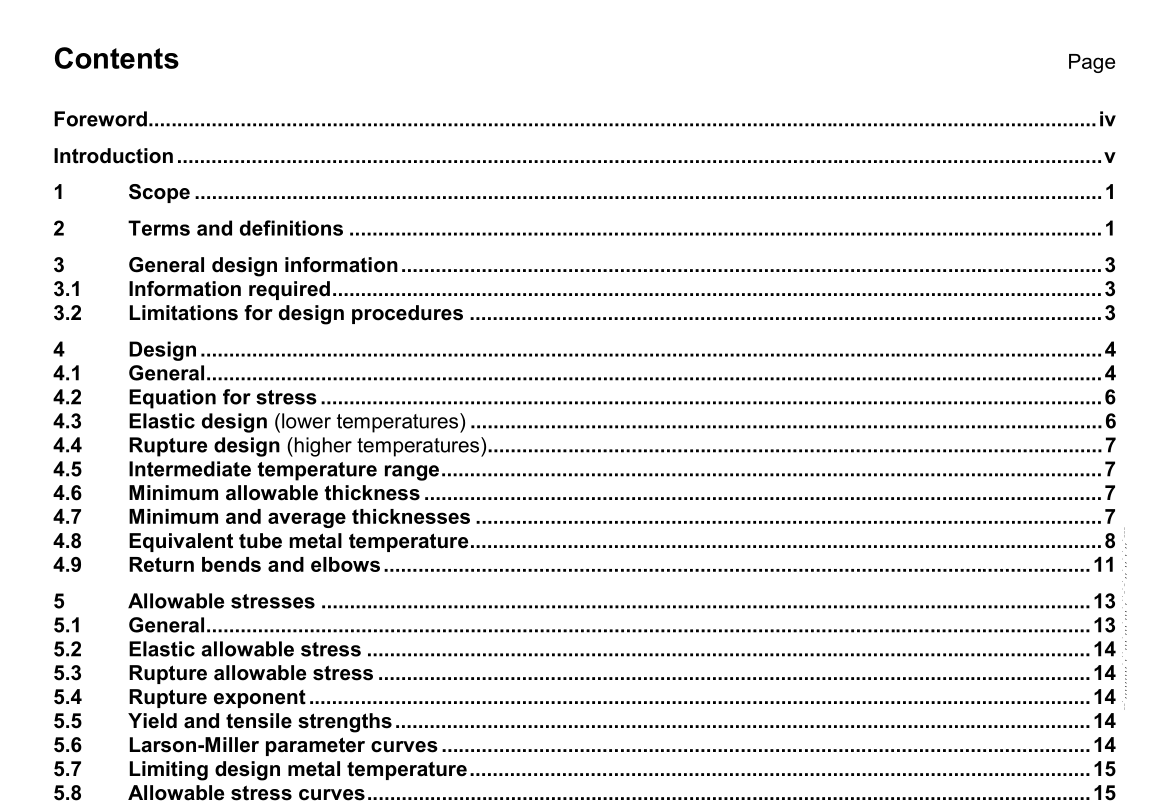API STD 530 pdf download

API STD 530 pdf download.Petroleum and natural gas industries — Calculation of heater-tube thickness in petroleum refineries
1 Scope
This International Standard specifies the requirements and gives recommendations for the procedures and design criteria used for calculating the required wall thickness of new tubes for petroleum refinery heaters. These procedures are appropriate for designing tubes for service in both corrosive and non-corrosive applications. These procedures have been developed specifically for the design of refinery and related process fired heater tubes (direct-fired, heat-absorbing tubes within enclosures). These procedures are not intended to be used for the design of external piping. This International Standard does not give recommendations for tube retirement thickness; annex A describes a technique for estimating the life remaining for a heater tube.
2 Terms and definitions
For the purposes of this International Standard, the following terms and definitions apply. 2.1 actual inside diameter D i inside diameter of a new tube NOTE The actual inside diameter is used to calculate the tube skin temperature in annex B and the thermal stress in annex C. 2.2 corrosion allowance d CA additional material thickness added to allow for material loss during the design life of the component 2.3 design life t DL operating time used as a basis for tube design NOTE The design life is not necessarily the same as the retirement or replacement life. 2.4 design metal temperature T d tube metal, or skin, temperature used for design NOTE This is determined by calculating the maximum tube metal temperature (T max in annex B) or the equivalent tube metal temperature (T eq in 2.7) and adding an appropriate temperature allowance (see 2.15). A procedure for calculating the maximum tube metal temperature from the heat flux density is included in annex B. When the equivalent tube metal temperature is used, the maximum operating temperature can be higher than the design metal temperature. 2.5 elastic allowable stress s el allowable stress for the elastic range (see 5.2) NOTE See 3.2.3 for information about tubes that have longitudinal welds.2.6 elastic design pressure p el maximum pressure that the heater coil will sustain for short periods of time NOTE This pressure is usually related to relief valve settings, pump shut-in pressures, etc. 2.7 equivalent tube metal temperature T eq calculated constant metal temperature that in a specified period of time produces the same creep damage as does a linearly changing metal temperature (see 4.8) 2.8 inside diameter i D ∗ inside diameter of a tube with the corrosion allowance removed; used in the design calculations NOTE The inside diameter of an as-cast tube is the inside diameter of the tube with the porosity and corrosion allowances removed. 2.9 minimum thickness d min minimum required thickness of a new tube, taking into account all appropriate allowances [see equation (5)] 2.10 outside diameter D o outside diameter of a new tube 2.11 rupture allowable stress s r allowable stress for the creep-rupture range (see 4.4) NOTE See 3.2.3 for information about tubes that have longitudinal welds. 2.12 rupture design pressure p r maximum operating pressure that the coil section will sustain during normal operation 2.13 rupture exponent n parameter used for design in the creep-rupture range See figures in annexes E and F. 2.14 stress thickness d σ thickness, excluding all thickness allowances, calculated from an equation that uses an allowable stress
3 General design information
3.1 Information required The usual design parameters (design pressures, design fluid temperature, corrosion allowance, and tube material) shall be defined. In addition, the following information shall be furnished: a) the design life of the heater tube; b) whether the equivalent-temperature concept is to be applied, and if so, furnish the operating conditions at the start and at the end of the run; c) the temperature allowance, if any; d) the corrosion fraction (if different from that shown in Figure 1); e) whether elastic-range thermal-stress limits are to be applied. If any of items a) to e) are not furnished, use the following applicable parameters: f) a design life equal to 100 000 h; g) a design metal temperature based on the maximum metal temperature (the equivalent-temperature concept shall not apply); h) a temperature allowance equal to 15 °C (25 °F); i) the corrosion fraction given in Figure 1; j) the elastic-range thermal-stress limits. 3.2 Limitations for design procedures 3.2.1 The allowable stresses are based on a consideration of yield strength and rupture strength only; plastic or creep strain has not been considered. Using these allowable stresses might result in small permanent strains in some applications; however, these small strains will not affect the safety or operability of heater tubes.









